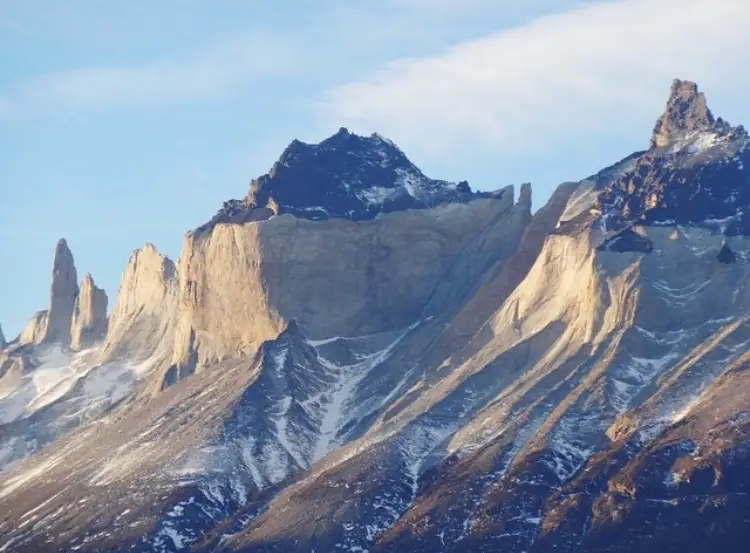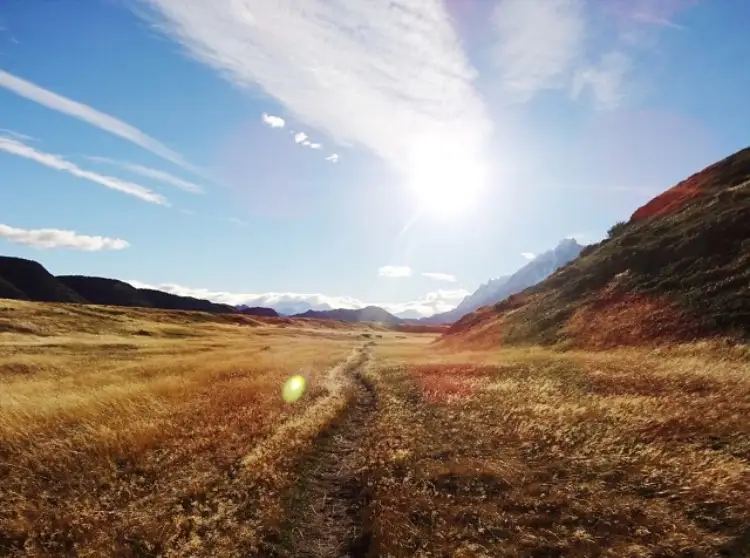How to Backpack Torres del Paine
Kimberly Collins | Dec 21, 2020

“We should just go.” These are the leading words to many a good story, no?
This time, as it often goes, they were said to me by a good friend over skype as we browsed blogs and bus routes and plane tickets. We were both already in southern Chile at the time — she on an island off the coast and I in northern Patagonia. But where we really wanted to be was Torres del Paine, a national park nestled deep in those wispy clustered islands at the bottom tip of South America. Named for its “towers of blue,” Torres del Paine is a ragged mountainous dream, and, as avid backpackers, we were desperate to get there.
We faced one primary hurdle, however: it was May, and the park had already closed for the approaching winter season.
So there we were, chatting on skype, trying to determine what, if anything, we could finagle in the off-season. We were just so close — might as well go take a peek, right? We could cozy up in a lodge, work from our laptops, swoon from a safe distance.
“We should just go,” she unceremoniously decided. And so 72 hours later, we both landed with our backpacks in Punta Arenas, a tiny town perched on the Strait of Magallanes in the south of Chile. So far south, in fact, that we were closer to Antarctica than to Santiago — hence concerns of winter.
Nevertheless, we were there to see what we could. From the airport, we shuttled to the bus terminal and hopped on the next bus to Puerto Natales, a town about three hours away, which lies closest to the park entrance. In Puerto Natales, we showed up on the doorstep of a hostel we had heard stayed open year-round — and that was as exactly as far ahead as we had planned. So there we were: eager feet, giddy smiles, and an extreme lack of solid information about the national park.
The hostel workers, however, were about to change that. Here’s how they greeted us:
“You two came at the best time of the year!”
“Come again?” we said. “We were just hoping to day hike.”
“Nonsense,” they replied, “you’ll do the full 5-day W trek.”
Torres del Paine boasts three main trek options, each masterfully named for its approximate shape from an aerial view: the W, the O (or full circuit), and the Q (which blends the two others). We knew the higher elevations of the O/Q trails would be impassably icy and had already ruled those out. We assumed the W would be out as well — so convinced, in fact, that we hadn’t even packed any equipment.
But as it turns out, early winter backpacking is not madness — it’s arguably the most ideal time.
Here’s the thing: for all its staggering mountain views, the W trail itself doesn’t scrape above 3,000 feet. Less elevation means less exposure. Despite possible snowfall and probable chill, early winter brings stunningly clear days and still mild enough climate. Shortening days mean you get to gape at each sunset and sunrise — a wonder not easily appreciated during summer days of 16+ hours of sunlight. Plus, a closed park means all the campsites are open and up for grabs.
But best of all, off-season means nearly-empty trails. In the summer, Torres del Paine can teem with hundreds of hikers daily. But in May? In five days, we saw six other people.

We’d be a little cold, the hostel workers advised us, and quite possibly wet. But in exchange, we’d get to witness the last vibrant colors of fall and the brilliant stillness of winter. We were sold. That night, they helped us rally our itinerary and lent us all the equipment we’d neglected to bring, and the next morning — 16 hours after we’d arrived, we were off.
Our itinerary lined up like this:
Day 1.
Morning bus from Puerto Natales to Guardería Laguna Verde (western park entrance).
Hike to Refugio Paine Grande, camp there.
Day 2.
Day hike to Glacier Grey and back (leave bulk of stuff at campsite).
Second night at Refugio Paine Grande.
Day 3.
Hike through the Valle Francés, up to the Campsite Británico and back down.
Camp at Los Cuernos.
Day 4.
Hike to the Torres Campsite.
Tuck in for an early bedtime there.
Day 5.
Pre-dawn hike up to the base of Los Torres for sunrise.
Return to campsite, pick up ready-to-go bags.
Hike out to the Guardería Laguna Amarga (east park entrance).
Bus back to Puerto Natales.
In total: 5 days, 4 nights, 64 miles.
And throughout those days? Wide eyes and weak knees all around. Every which way we turned we saw scenery plucked out of a calendar or backpacking magazine or Ansel Adams collection. You know, the kind of backdrop where you’re consistently a little startled it’s not a green screen, baffled at how you got so undeservedly lucky to be in it. Lakes of turquoise, glistening with glacier-fresh water (#nofilterneeded). Pampas of sun-streaked grasses gleaming in the wind. Sudden white peaks piercing a sapphire sky. Everything glowing pink in the sunset. Two happy hearts treading lightly, breathing deeply, and telepathically bear-hugging those hostel workers for nudging us out the door.

Of all the unceremonious decisions we’ve made, this was among the best. Further proof that things rarely go according to plan, but they sometimes work out infinitely better — and we really should just go.
About the Author

Raised in Indianapolis, Kimberly now writes and travels from Montevideo, Uruguay. After studying global politics, she worked for a small tech company until a 2016 Fulbright grant plopped her in Uruguay. She’s since finished the grant but opted to stay abroad, continuing to advance her Spanish, bop around South America, and soak up all the learning and dancing she can.
Search Posts
Receive our monthly inspiration and travel tips from the travel insurance experts.
Sign me upThis website and various social media updates provided by Seven Corners contain content, information, articles, videos, and links to websites created by third parties. Seven Corners, its owners, and its employees neither endorse nor are responsible for the accuracy, timeliness, or reliability of any third-party information, statements, opinions, or advice and are not liable for any loss, harm, or damage caused by your reliance upon them. Use of such information or the linked websites is entirely at your risk. Concerns regarding this third-party content should be directed to the third party. Seek professional advice, as appropriate, regarding your use of such information and websites.
Because the information on this website and in Seven Corners’ blogs and other social media is written and compiled using knowledge and information available at a certain point in time, it may become outdated. For that reason, information, events, legal requirements, and product changes (including benefits, limitations, exclusions, and services) may not be up-to-date, complete, or accurate at the point in time it is being read. Again, use of such information is at your risk.
